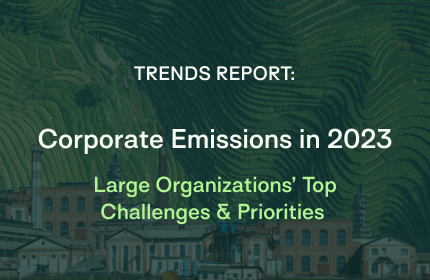On March 6, 2024, the SEC voted to adopt new climate disclosure rules, two years and over 24,000 public comments after the new rules were originally proposed. The public comment period had a tangible impact on the final, approved rule—a proposed requirement to include scope 3 reporting was struck, for example—but the final rule is not without controversy. Dozens of states have filed lawsuits saying that the rules go too far, while environmental organizations including the Sierra Club are considering legal action for the opposite reason. On April 4, the SEC voluntarily stayed the rules, pending review by the Eighth Circuit Court of Appeals.
That review could take years to complete. While some compliance requirements were set to take effect in 2025, it is likely that the SEC will push back that timeline in light of the stay. In the meantime, investor pressure for climate risk transparency remains high, and other regulations, including California’s SB 253 and SB 261, require even more extensive disclosures than the SEC’s paused rules. We will continue to update this resource as litigation over the rules proceeds.
Want to download this resource so you can come back to it later? Click here to download the guide in ebook form >
Key takeaways:
- The new rules aren’t groundbreaking, but they are meaningful
- Scope 3 emissions data is still in-demand, despite its absence from these rules
- Accurate, actionable data is the key to change
Please note that while this article is not legal advice, Optera can help your company prepare for compliance with the SEC’s climate disclosure rules, in particular setting and managing targets, emissions accounting and disclosures, and climate risk consulting. Click here to schedule a demo >
Summary: What are the SEC’s climate disclosure rules?
If these rules clear litigation, they will require public companies in the United States to disclose scope 1 and 2 greenhouse gas emissions (in some cases), climate-related risks, board oversight and management of those risks, and climate-related goals which could have a material impact on the business.
The rules are intended to give potential investors transparency about the risks facing a company, so they can make an informed investment decision. Similar disclosure rules for other types of risk have existed since the 1930s, when lawmakers and the public blamed the Great Depression on a lack of corporate transparency and the SEC was formed in response.
Who will be subject to the SEC’s new climate disclosure rules?
All companies that are publicly traded on a stock exchange in the United States will be subject to the new SEC climate disclosure rules if they take effect, just like any other SEC disclosure requirement. The climate disclosure rules include all filing classes—large accelerated filers (LAFs), accelerated filers (AFs), non-accelerated filers (NAFs), smaller reporting companies (SRCs), and emerging growth companies (EGCs)—with the largest companies required to comply first and the smallest companies on a longer timeline.
When do the SEC’s climate disclosure rules become effective, and when do companies have to comply?
This set of climate disclosure rules was set to become effective on May 28, 2024; however, the voluntary stay by the SEC puts that on hold until the rules clear their current legal challenges.
If the rules do take effect as-is, LAFs must comply first, submitting the new disclosures related to severe weather events, carbon offsets, and renewable energy credits (RECs) on their financial statements. That was originally scheduled to take effect starting in 2025, with AFs, NAFs, SRCs, and EGCs following in 2026 and 2027. Further disclosures, including GHG emissions, assurance, and more, would phase in on a rolling basis. The final compliance phase was set to take place in 2033, when LAFs were required to comply with the “reasonable assurance” guidance. It is likely that these timelines will shift back, based on how long the legal challenges to the rules take.

What do the SEC climate disclosure rules require?
These climate disclosure rules require public companies to disclose material climate-related risks; targets; goals; scope 1 and 2 emissions (for large companies only); carbon offsets and RECs; and the impact of severe weather, natural conditions, and climate strategy on the bottom line.
Keep reading for a full breakdown of each.
Material climate-related risks
Registrants must disclose climate-related risks that have or could have an impact on their strategy, operations, finances, business model, or outlook, and must outline what those actual and potential impacts are or could be. Additionally, if the business has taken action to mitigate that risk, they must disclose those mitigation actions and the costs associated with them.
The business must also disclose its risk management process for climate-related risks along with the governance structure surrounding it, including board oversight and the role of management. Management expertise on the climate must also be disclosed, though an original proposal to require disclosure on board expertise was struck.
Material climate-related targets, goals, and transition plans
If a company has set climate-related targets or goals— a net-zero goal or SBTs, for example—that have impacted or could impact their finances, they must disclose the details of those goals and what their impact is likely to be.
Material scope 1 and 2 emissions
LAFs and AFs must disclose material scope 1 and scope 2 emissions, and eventually an assurance report. LAFs must submit limited assurance starting in 2029 and reasonable assurance in 2033, while AFs are required to submit limited assurance starting in 2031.
Severe weather events/natural conditions
When severe weather or sea level rise results in costs, expenditures, or losses equal or greater than one percent of stockholder equity or deficit in that fiscal year (subject to a de minimis threshold of $500,000), the company must disclose those losses. Further, if severe weather or natural conditions impact the estimates and assumptions that a company uses to prepare their financial disclosures, they must describe how those estimates and assumptions were changed.
Carbon offsets and RECs
Companies who use carbon offsets and RECs to achieve their climate targets must disclose the costs associated with those offsets and RECs.
Materiality — what does it mean? Is it open to interpretation?
Nearly all of the requirements within the SEC’s new climate disclosure rules are subject to materiality. Whether something is “material” is up to the company’s discretion, with guidance from the SEC that materiality is determined by whether a “reasonable investor” would consider it important when making an investment decision.
Each reporting company must make their own decisions on what constitutes materiality. Because those decisions are subjective, each company is likely to define materiality differently, with the potential that an investor or SEC might disagree with that definition. The original climate disclosure rule proposal included a requirement for companies to disclose their process for determining materiality, but that requirement was struck from the final rules approved by the SEC.
Where disclosures are reported
Several elements of the required disclosures must be included as notes on the company’s registration statements and in their Exchange Act annual financial reports:
- Costs, expenditures, and losses associated with severe weather events and natural conditions
- Costs, expenditures, and losses associated with carbon offsets and RECs
- Material impacts to the estimates and assumptions the company uses to compile its financial statement, resulting from severe weather events/natural conditions, climate targets or goals, or a climate transition plan
It is up to the company whether these disclosures are contained within a separate “Climate disclosures” section of the report or are incorporated into pre-existing, related sections. Regardless, they must be tagged using Inline XBRL. This brings sustainability reporting in line with well-established financial reporting methods. According to Workiva’s 2024 Executive Benchmark on Integrated Reporting, companies who integrate sustainability reporting and financial reporting are twice as confident in complying with the SEC’s new rules as those who do not.
Companies that are required to disclose GHG emissions and their assurance reports (LAFs and AFs) can present that information within or as an amendment to the annual Form 10-K report, or in the quarterly Form 10-Q report (in which case the disclosures should be included no later than the second fiscal quarter following the year of the disclosure).
Why did the SEC propose new climate disclosure rules?
Investors have increasingly demanded clarity on sustainability initiatives for decades now, as illustrated by the rise of ESG funds and voluntary corporate sustainability reports. However, while most large companies do publish sustainability information voluntarily, those reports differ widely from one company to another. The SEC’s climate disclosure rules aim to introduce standardization, so that investors can compare companies to one another using consistent information.
Original proposal vs approved rule
The SEC first solicited public input on potential climate disclosure rules in March 2021, and published their proposed rules a year later in March 2022. While the original public comment period was slated to last just 60 days, the proposal generated such a response that the SEC spent two years reviewing an unprecedented 24,000 public comments, including input from business groups, lobbyists, and corporations. The final rules, approved in a 3-2 vote on March 6, 2024, were significantly scaled back from the original proposal.
Scope 3 emissions reporting
The original proposal specified that companies disclose scopes 1, 2, and 3 GHG emissions (excepting smaller reporting companies and emerging growth companies). While the SEC justified scope 3 inclusion by stating that many companies already disclose scope 3 emissions “based on broadly accepted disclosure frameworks, such as the Task Force on Climate-Related Financial Disclosures and the Greenhouse Gas Protocol,” it was removed from the final rule.
Materiality threshold
Most of the final rule’s requirements are subject to a materiality threshold. While this was present in some of the draft proposal, it was a new addition to the “climate target and goals” disclosure section.
Company size and filer status
The final, approved rule specifies that only LAFs and AFs must report their scope 1 and 2 emissions—smaller and emerging companies are exempt. That exclusion was not part of the original proposal.
Additional changes between the proposal and the final rule were extensive. Check out PWC’s breakdown for a comprehensive overview.
The SEC climate disclosure rules and the TCFD
Both the original proposal and the final climate disclosure rules are based on the Task Force on Climate-related Financial Disclosures (TCFD) framework, so companies that already follow this framework have a head start on compliance with the new rules.
Of note: while the final, approved rules eliminate scope 3 emissions reporting, they maintain disclosure of climate-related risks without specifying where in the value chain those risks originate. For most organizations, this means that Scope 3 emissions accounting and management will be implicitly required, even though disclosure of those emissions is not required by the SEC. With scope 3 emissions comprising an average of 75 percent of a company’s carbon footprint, they make up a significant portion of climate-related risks and impact.
“Emissions reporting is strictly scope 1 and 2. However, for most companies the largest emissions categories – and therefore some of their most significant climate risks – result from their value chain, their Scope 3 emissions. And because those are so central to a company’s climate risk, TCFD-aligned scenario analyses, and forward planning—the SEC has effectively implied that Scope 3 emissions must be accounted for and managed, even if not disclosed explicitly,” says Ty Colman, Optera CRO and co-founder. Within the TCFD framework, companies must calculate Scope 3 emissions and their related risks “if appropriate.”
How do the new SEC climate disclosure rules interact with state-by-state legislation and EU climate disclosure regulations?
California’s SB 261 requires companies to disclose climate-related financial risks (in line with the TCFD framework, like the SEC rules), while SB 253 requires companies to disclose their emissions, including scope 3, unlike the SEC rules. New York and Illinois are considering similar emissions disclosure requirements. Any company doing business in these states—which includes many, if not most, large companies impacted by the SEC rules—will be subject to their requirements when they take effect.
Similarly, many large companies have annual revenues within the European Union that exceed 150 million euros, meaning they are subject to the EU’s Corporate Sustainability Reporting Directive (CSRD). The CSRD requires companies to disclose scope 1, 2, and 3 emissions, as well as the impact of the climate on their business and the impact of their business on the environment.
Each of these regulations is different, meaning that companies who are subject to all of them may need to tread carefully. According to law firm Goodwin Law, “Areas of potential concern may include potentially duplicative or inconsistent regulatory reporting and/or public disclosure requirements and different protocols or frameworks that apply to these requirements…there may not be a one-size-fits-all solution.”
Key takeaways—how does this impact corporate climate strategy? What should you do next?
The new rules aren’t groundbreaking, but they will be meaningful
The SEC is a lagging indicator of market pressures. ESG funds first appeared in the 1990s, and corporations began voluntarily publishing sustainability reports even earlier, in the 1980s. Today, 96 percent of the world’s largest companies are reporting on sustainability, and investors largely expect sustainability metrics to be available on-demand. The World Economic Forum, the EU, state legislatures across the US, and other regulators are demanding increased transparency on emissions and climate-related risks. In this context, the SEC’s new climate disclosure rules are not a shocking departure from the norm. They will be a welcome and meaningful step forward toward standardization and impactful climate regulation, provided they survive their current legal challenges.
Scope 3 emissions disclosures are still in-demand
While removing scope 3 emissions reporting as a requirement from the final rules came as a disappointment to many in the sustainability industry, it was not a surprise given the tenor of the two-year long public comment period. And scope 3 disclosures will be required for many large companies anyway, thanks to regulations in California and Europe, where a vast majority of large global companies do business. Plus, scope 3 emissions remain a central part of most company’s climate-related risks and forward planning—meaning that managing scope 3 emissions is still critically important, if not explicitly required, under these new rules.
Plus, customers and investors have made it clear that they want proof of what companies are doing to transition to the low-carbon economy. Because scope 3 emissions make up such a large percentage of most companies’ emissions, external pressure for scope 3 transparency is mounting every day.
“The only thing holding back more meaningful climate regulation is the prevalence of inaccurate and inactionable Scope 3 data,” says Tim Weiss, Optera CEO. “We are solving that problem for the largest companies in the world, so while the SEC does not require Scope 3 today, I have no doubt that it will in the coming years.”
Accurate, actionable data is the key to change
Today’s regulatory focus on disclosure means that many companies spend too much time on data collection at the expense of action. Estimates, assumptions, and inaccuracies are widespread in emissions data, presenting a major challenge to companies and regulators who want to move the needle on decarbonization but instead must spend the bulk of their time collecting, reviewing, and cleaning up numbers.
The next step for companies who want to decarbonize is to streamline and standardize their emissions management process. When accurate and specific data is at their fingertips, companies can switch their focus to meaningful climate action—a challenge that Optera is taking on and solving with the world’s largest companies.


